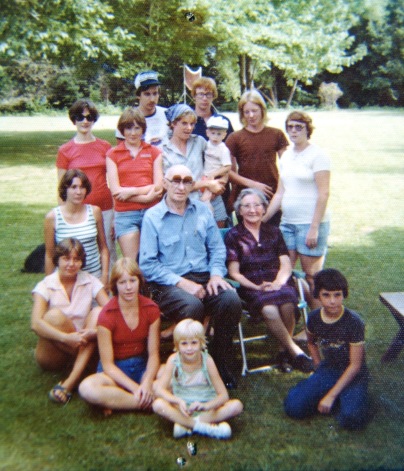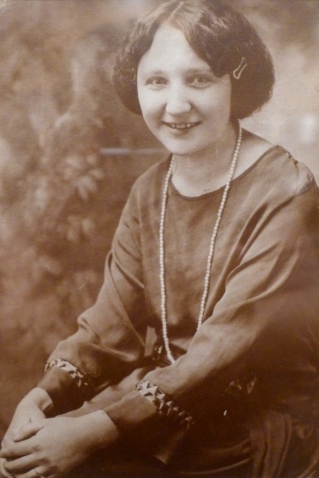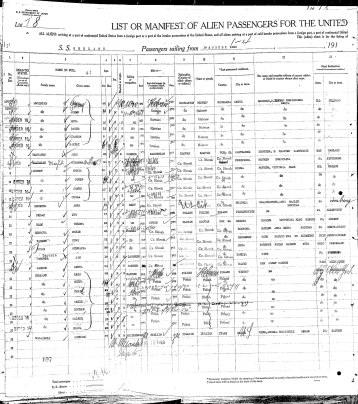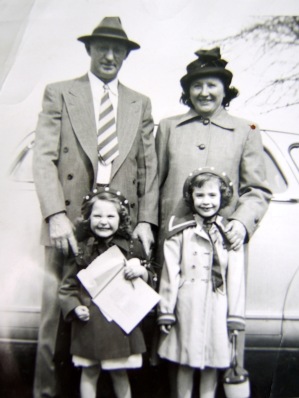Anna “Anne” Marie Devecka Paytas (1906-1982) was my great-grandmother on my mother’s side. She was also the first ancestor that really made me excited about researching my family tree. In part this was because my father’s line, which goes back to kingdom come, was full of well-researched WASPs, while the Devecka line was my more mysterious Eastern European ancestry. And in part this was because I look like her, my mother looks like her, and her mother looked like her. The Slovak blood is strong in us. And the most important reason I became interested in learning more about Anna? Because she has a really amazing story.
Anna was born in Pittsburgh, Pennsylvania on Sept. 8, 1906. Her parents were Martin Devecka and Eva Majzlik, who I suspect married because of Anna’s impending birth, as census records indicate they married in late 1905 or early 1906. I have no record of their marriage yet so this could just be wishful thinking, but either way, Eva was just 16 years old when her daughter was born. She and her husband were recent immigrants from Slovakia, then part of Hungary. They immigrated separately, but probably met because they were from the same region in their home country, Liptovsky Mikulas, and were part of the Protestant minority. Many immigrants tended to form their own communities in America. Eva had come over in November 1903, at the age of 13, lying on the Ellis Island manifest and saying she was 15, probably to ensure that she was considered old enough to work. Martin, who was 22 when his first child was born, had arrived in America in the winter of 1902, settling in the Woods Run area of Pittsburgh in May 1903, then called old Allegheny City. This area borders the North Side, where an industrial riverfront attracted many Slovak, Czech and other Slavic families in the early part of the 20th century.
Soon after Anna’s birth, Eva returned to Slovakia. No one in the family is sure of why she did this – it could have been that she wanted to show her daughter off to her family there – but it was common for recent immigrants to make trips home. Eva’s hometown was Pribylina, a village in Liptovsky Mikulas that has been around since at least the 1200s, and my Majzlik family lived there for hundreds of years. Since “majzlik” literally means “chisel,” they were probably stone cutters at one point in time, though by the early 1900s, they were peasant farmers eking out a living in a depressed area, which is why many of their number were immigrating to the US.
When Eva and Anna got to Pribylina, Anna was introduced to her grandmother Anna, called Hana, whom she was probably named after, and then handed off to an aunt. Eva and her mother, who was a widow of about 55, then left for the city of Bratislava to find work in the factories there. Eva earned enough money to return to the US, with one small catch – she didn’t take Anna with her. Anna, now three, was abandoned in Pribylina – and her mother never explained why. This hurt Anna deeply for the rest of her life.
B y 1909, Eva had returned to America, and in 1910 she and Martin were living in a boarding house on the North Side with other Hungarian Slovaks. He worked for the Pittsburgh Locomotive and Car Works, a railroad manufacturing company founded by Andrew Carnegie in the 1860s. Anna remained in Pribylina with her grandmother and aunt, among other relatives. It was likely that Eva couldn’t work with a small child and Martin had trouble supporting them all on one income, but this decision – to leave her daughter in Hungary – was going to have a big impact on everyone’s lives, in part because of what was about to happen to the Austro-Hungarian Empire.
y 1909, Eva had returned to America, and in 1910 she and Martin were living in a boarding house on the North Side with other Hungarian Slovaks. He worked for the Pittsburgh Locomotive and Car Works, a railroad manufacturing company founded by Andrew Carnegie in the 1860s. Anna remained in Pribylina with her grandmother and aunt, among other relatives. It was likely that Eva couldn’t work with a small child and Martin had trouble supporting them all on one income, but this decision – to leave her daughter in Hungary – was going to have a big impact on everyone’s lives, in part because of what was about to happen to the Austro-Hungarian Empire.
In the summer of 1914, Anna was 7 and a half years old. Her aunt, who was one of her mother’s much older half-sisters, made her clothes for her and was generally kind. They lived just a few houses from the Lutheran church in town. Then the Austrian Archduke Franz Ferdinand was assassinated in Sarajevo, throwing the world into turmoil. The First Wold War had begun, and it was especially difficult for the Slovaks. Not only were they, as Hungarian citizens living in the western part of the Empire, caught between the warring factions of Europe, but they had been seeking independence from the Empire. With the death of Franz Ferdinand, who was supporting Slovakian autonomy, they were left to plan their campaign for independence in secret, At one point during the war, Slovak and Czech politicians held a secret meeting in Liptovsky Mikulas, a town just 10 miles from Pribylina. They were truly at the epicenter of the war.
During the war the Hungarian government, which had already been forcing the Slovakian population to assimilate for the past 30-odd years, began to crack down, censoring the Slovakian people even more in an ethnic cleansing called magyarization. Men in the town were conscripted into the Hungarian army for the war effort in the east against Russia, including Anna’s uncle Adam Majzlik, who never returned. Church bells were even melted down to make cannons for the war. The war ended in late 1918, when Anna was 12. The Austro-Hungarian Empire was no more.
A year and a half later, Anna was deemed old enough to work. which meant she could join her family living in the United States. At 13 and a half, she was the same age her mother had been when she’d come to America just 18 years earlier. Her Ellis Island record shows that she was listed as a Czechoslovakian, and then that was crossed out and someone hand wrote “US Cit” across the page. This was an important distinction. After the Great War, American immigration policy changed drastically, and if Anna had not been born in the United States, she may very well have not been allowed in.
In 1920, Martin and Eva were living in Sharon, Pennsylvania, having both been naturalized in March. They’d done some “planned” parenting, waiting until 1912 to start having children again, which meant that Anna, or Anne, as they called her, had four younger siblings she had never met before. They were all under the age of 5, and she was expected to take care of them during the day.
Anne hated it. She was a stranger in a strange land. She was an American citizen who spoke with a broken accent and carried all of the customs of a foreign culture with her, unlike her Americanized siblings. She hadn’t been back on her homeland’s soil since she was an infant or toddler, and most likely couldn’t remember America at all, let alone the mother who had left her at three. There were certainly letters sent back and forth between the two countries – Martin lists her intimately as “Annie” in his US citizenship papers, but that was it. And now, back in the bosom of her family, she was expected to immediately become what amounts to an unpaid nanny. Most older children babysit their younger siblings in large families – it’s been the way of the world for centuries. But most older children aren’t estranged from their families for over a decade.
The Deveckas soon moved back to Pittsburgh, where there was more work for Martin at Pressed Steel. Anne found a job as a live-in maid or nanny in the household of Dr. Donald Gauger Lerch, a local area physician and surgeon. Mrs. Anna Lerch was a new mother in her early thirties, from a well-to-do family in Philadelphia. She soon discovered that Anne couldn’t read or write English, not a surprising fact considering any schooling she’d had would have been in a Hungarian-dominated country. Mrs. Lerch volunteered to teach her and was amazed to discover how clever Anne was and how quickly she learned. Anne’s memories of life in the Lerch household were fond, but that was soon to end.
Anne was told by her family that a marriage had been arranged for her. This was surprisingly common in immigrant Slovak communities, even among the children of immigrants. Anne, as a recent immigrant herself, for all that she was American, would not have thought to complain. The marriage was arranged right down to the selection of the wedding rings, and on Mar. 1, 1924, at the age of 16, Anne married Matthew Paytas, a Slovakian dairy farmer from a neighboring county. After three and a half short years learning how to manage in a big city like Pittsburgh, she was in for another complete life change.
The Paytas’ dairy farm was in Cranberry Township, a bucolic rural community in Butler County, about 20 miles north of Pittsburgh. There, Anne was expected to live with her new in-laws, Joseph and Eva Paytas, helping out on the farm and raising vegetables in their large garden to sell. Matthew Paytas, her new husband, was tall with light red hair and a long, square face. He was also adopted. His adoptive parents had taken him in as a small child, more as a way of gaining free labor rather than gaining a son. They treated him unkindly, and life in the Paytas household was far from being a warm, loving family environment.
Anne got pregnant within a month of being married. Her first child, a girl she named Irene Marie, was born Jan. 16, 1925. This was my grandmother. She was only a month younger than her uncle, Anne’s youngest brother Albert, who was born Dec. 16, 1924. Anne had three more children, who were born in quick succession – Helen Jane in 1926, Dorothea “Dorothy” Ann in 1928 and finally a son, Jerome “Jerry” Richard, born in 1932. The children all attended the Graham School, a one room schoolhouse near the farm in Cranberry. The Harmony streetcar line went through the township, offering a low rate for passengers headed to and from Pittsburgh. Being part of such a tight-knit ethnic community meant that the Paytas family might have traveled to their church, Emmanuel Slovak Evangelical Lutheran, in the North Side, for special occasions, maybe even taking the train. But money was tight. At the beginning of the 1930s, fewer than a third of the farms in Cranberry had electricity, and it is doubtful that the Paytas’ would have invested in it. Farm life was hard, and it was about to get harder.
It was the Great Depression. Joseph Paytas’ wife had died in 1931, and soon after he decided to sell the farm. He didn’t give Matthew a choice in the matter, so the Paytas family suddenly found themselves without a home or jobs. Joseph moved to live with his brother’s family, and they moved to Monaca, in Beaver County, where Matt found work at the Sanitary Works. It should have been a relief to be out from under the thumb of the Paytas elders. But Matthew was not always a happy man, and there were rumors in the family that he could be abusive, whether verbally or physically, no one knows really knows for sure.
He and Anne were hard workers, and as the ’30s slid by, they found themselves on firmer footing. By the time Irene was in high school, they had gone back to farming in New Sewickley Township. According to family records, they purchased, for cash, 20 acres, which included a “fine home” and a barn. Their garden was for their own use for the first time and there were chickens and a few fields of grain for feed. Matt continued his work as a mixer at the Sanitary Works, and later for the American Bridge in Ambridge during WWII. He did his farming in the evenings and during the weekends, with Anne and the kids shouldering their share of the work.
Irene graduated from Freedom High School as the class valedictorian in 1943. It must have been a proud moment for two parents who’d had such hard-scrabble lives and had come from broken families. Denied the opportunity to succeed at an early age, Anne and Matt saw the American Dream realized in the lives of their children. Their second daughter, Helen, got a job as the head bookkeeper in the office of the Freedom Oil Co., where her father was just a maintenance engineer. They would see their third daughter, Dorothy, become the class salutatorian. Their son Jerry joined the military, served in the 82nd Airborne as a paratrooper and a sergeant during WWII, and then went on to graduate from Geneva College. He later became an accountant and married an Italian-American registered nurse named Norma Tavolier. Irene worked at the Freedom National Bank before marrying a local Hookstown farmer, Richard S. Elliott, and Dorothy married WWII veteran Bob Campbell of Beaver Falls. After 10 years of work, Helen finally married a career military man, Chuck Whitmore. Helen and her husband lived an interesting life of travel because of his job – one of their children was even born in Morocco! By 1974, when Matthew and Anne celebrated their 50th wedding anniversary, they had 15 grandchildren and 3 young great-grandchildren. They had lived to see all of their children marry, lead fulfilling middle class lives, and they had achieved the success of being able to “retire” to their farm.

Back row (left to right): Dale and Scott Campbell (Scott is the redhead). 3rd row: Lois Elliott, Robin Whitmore, Becky Paytas, Paul Brown (in Becky’s arms), Gary Whitmore (with the long blond hair) and Carol Elliott Brown. 2nd row: Cindy Campbell (kneeling), Matt and Anne Paytas (seated). Front row: Anita Paytas, Susan Whitmore, Laura Brown, Jerry Paytas, Jr.
There are elements to Anne’s story I know I am missing, because my mother and her siblings lived half an hour to an hour away, and didn’t often get to see the Devecka side of the family or visit “PawPaw” and “Grandma” on their farm. Anne’s relationship with her mother, for example, is a complicated mystery. While Anne was hurt by the abandonment and treatment she experienced as a child, as an adult she and her mother would visit and chatter away together in Slovak – closer perhaps because of their shared background than any of Eva’s other children. After all, they were both raised by the same woman in the same home on the same little village street in Slovakia, and may have felt more like sisters than anything else.
In 2014, after the funeral of my great-aunt Dorothy’s former husband, Uncle Bob, I got to meet two of my mother’s cousins for the first time as an adult. I was telling them some of the highlights of their grandmother Anna’s life story. This included the recent discovery that the Devecka last name was actually spelled Devečka in the old country, and was probably pronounced De-vesh-ka. When I said that word out loud, my cousin Cindy, who had been walking to the kitchen to get a drink, popped her head around the corner of the wall and exclaimed, “I remember that! I remember grandmother and her mother Eva talking in Slovak when I was little, and that’s the way they said Devecka!” Hearing the old pronunciation of the family name brought it all rushing back for her.
Anne lived to be 74. She died May 21, 1982, just 7 and a half months before I was born. Her husband and she had entered the Rees Nursing Home in New Castle, and Matt had died of bone cancer the summer before. Her mother, the tough old bird, had lived to be 87, and had only passed away 5 years previously. It’s hard to know what Anne thought of the course of her life, and the role her mother played in it. Eva was a woman hardened by a difficult existence, and my mother, aunts and their cousins only remember her as a “scary, mean old lady.” But Anne was completely different. Though she never lost her thick Slovak accent, she had a sunny personality and is remembered as being sweet, loving and always smiling. Her heartfelt joy just beams forth from every family picture. She seemed to take life in stride, and each new challenge was met with perseverance and a positive outlook on the future. I’m so happy to have inherited her smile.
This story was compiled from family memories, census, church and Ellis Island records, and from the pages of a family manuscript called “The Devecka Family Tree,” written by Anne’s brother Edward Walter Devecka, Sr. in 1983. For further citations please see my family tree on Ancestry.com.



Pingback: 52 Ancestors in 52 Weeks | From Europe to America
Pingback: 52 Ancestors in 52 Weeks | From Europe to America